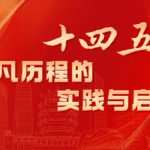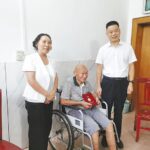Volunteers provide services for tourists
To help visitors efficiently explore Wuhan and fully demonstrate the warmth of this heroic city, on the morning of October 17th, Wuhan cultural tourism volunteers arrived early at Wuhan Railway Station to carry out volunteer services. The red vests and green T-shirts stood out prominently in the crowd. This service was themed “Autumn Wuhan Trip, Volunteers Accompany Your Heart,” with volunteers focusing on the core goals of “promoting Wuhan and spreading care,” providing multi-dimensional and thoughtful services to passing tourists.
On the information desk display boards, Wuhan tourist maps and Qintai Music Festival brochures were neatly arranged, offering both practical use and collectible value, serving as “mini guides” for visitors to learn about Wuhan’s attractions and cultural activities. Whenever tourists stopped by, volunteers proactively approached them, politely offering maps and brochures with both hands for visitors to keep as souvenirs.
When a mother with her child received the materials, the child immediately pointed to East Lake on the map and asked: “Mom, are there many lotus flowers here?” Seeing this, the volunteer smiled and added: “East Lake is even more beautiful in autumn, with large areas of maple leaves, and you can also take boat rides on the lake!” In this simple interaction, warmth flowed naturally.
Additionally, volunteers also served as Wuhan cultural guides, with the temporary explanation area around the information desk frequently surrounded by tourists. One volunteer pointed at the Yellow Crane Tower on the large screen, speaking clearly and expressively: “‘The sage on yellow crane was gone amid clouds white. To what avail does Yellow Crane Tower remain?’ The Yellow Crane Tower became famous nationwide because of this poem by Tang Dynasty poet Cui Hao, and together with Yueyang Tower in Hunan and Tengwang Pavilion in Jiangxi, they’re known as the ‘Three Great Towers of Jiangnan.'” As she spoke, she used her fingers to point out the details of the flying eaves on the Yellow Crane Tower. Several tourists from Henan nearby listened attentively, nodding and praising: “So this poem was written about it, now I understand why it’s so famous!”
Meanwhile, volunteers didn’t forget to recommend recent cultural activities in Wuhan to tourists. “From October 17th to November 15th, the 14th Qintai Music Festival is being held in Wuhan, featuring theater music, community choir performances, and citizen music salons – over 50 high-quality performances in total. If you’re interested, we can go to Qintai Concert Hall to watch a performance, and you can get there by subway!” This introduction by a volunteer made many tourists’ eyes light up, with one young visitor immediately taking out their phone to note it down: “I happen to be staying in Wuhan for a week, maybe I can catch a performance!”
Volunteers also gave explanations around “Wuhan’s Autumn Cultural Memories”: they vividly described how the “Hanyang Tree” from the poem “Hanyang trees loom in sun so bright” refers to an ancient ginkgo tree located in Hanyang, one of Wuhan’s three towns, explaining that in a short while visitors could appreciate the beautiful golden scenery when the tree’s leaves change color; they detailed “East Lake’s Historical Changes and Autumn Scenery,” describing its transformation from a suburban lake to today’s urban green heart, and portraying the layered colors of autumn reflected in the lake and mountains; they vividly interpreted “The Autumn Charm of Hankou Historical District,” combining historical stories behind old buildings with descriptions of dappled sunlight falling on red brick walls in autumn.
Considering different tourists’ travel needs, volunteers also provided “point-to-point” transportation planning advice, solving visitors’ travel challenges with meticulous service. When assisting elderly tourists, volunteers would slow down their speech, pointing at bus and subway routes on the map while repeatedly explaining. When encountering tourists unfamiliar with routes, volunteers would personally accompany them to boarding points, only returning to the information desk after seeing visitors successfully board their transportation. An elderly visitor who came to Wuhan to visit relatives said emotionally: “I was originally worried about finding the subway station, but thanks to these young people, they’re more careful than my own children!”
This special service initiative by Wuhan cultural tourism volunteers not only provided practical and effective assistance to tourists traveling during off-peak periods but also, through professional and detailed service, made the city’s “warmth” and “care” tangible, transforming visitors from “passing through Wuhan” to “understanding Wuhan,” and from “checking in at River City” to “falling in love with this city.”






